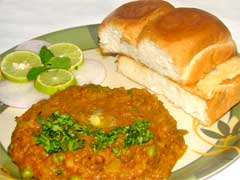Before I deliberate on the genius of Academy Award winner Allah Rakha Rahman, or popularly known as AR Rahman, let me first talk about the quintessential culinary invention of Mumbai streets, the paobhaji or the pavbhaji (if you may like). Evolved and born from the numerous by lanes of Mumbai, this delectable fare is undoubtedly the second most popular food-item, if not the first one (vada pao being a close competition). Every evening thousands of itsy-bitsy carts appear all across the city, a big oval flat-pan in the centre on which the bhaji is made. It is a staple food for most Mumbaikars who prefer it on the go. Cheap and affordable is the biggest factor that works in the favour of paobhaji, generally available under 30 rupees, it is in arguably the most common dinner dish across the city. Even so, there is no disputing how tasty the ubiquitous and humble paobhaji is. Eaten with a few paos and more that are toasted in butter, it fairly fills up the tummy and also tingles the taste buds.
Even so, anyone who makes a good paobhaji will tell you that there is no ‘good’ way of making a paobhaji; this yummy dish is more made by instinct than by design. While the elements that go into the making of paobhaji are more or less the same, yet it is the permutations and combinations between them that distinguish between a common road fare and a classy one. The basic process is to make a spicy paste of tomatoes and onion, add boiled  potatoes, cauliflower and boiled peas. And then with an aid of a heavy hand-stamp sort of implement, the whole mixture needs to be crushed, evened out and left to simmer for a few minutes. Finally for garnishing add coriander and a few dollops of butter. The bhaji is served with crispy paos (cooked in butter again) and thinly sliced raw onions and a few cut pieces of lime. This is the basic model, and above that a lot of customisations can be done, for instance adding cheese, putting in dry fruits, incorporating other vegetables or spices in the same.
potatoes, cauliflower and boiled peas. And then with an aid of a heavy hand-stamp sort of implement, the whole mixture needs to be crushed, evened out and left to simmer for a few minutes. Finally for garnishing add coriander and a few dollops of butter. The bhaji is served with crispy paos (cooked in butter again) and thinly sliced raw onions and a few cut pieces of lime. This is the basic model, and above that a lot of customisations can be done, for instance adding cheese, putting in dry fruits, incorporating other vegetables or spices in the same.
Yet, as mentioned earlier even though the process is fairly defined, there is not template for making a good paobhaji. The taste and the brilliance of paobhaji is largely dependent on the individual who is cooking it. The best master follow their instincts in terms of aroma, viscosity and the colour of the bhaji. At all times will they be attentive to how the bhaji is turning up and tweak and change gears accordingly, thus, if it’s turning redder, more potatoes will be added, too dry and extra water will be poured. Because of this inherent dependency of the dish on the one who is preparing it, paobhaji has not found favour with the bourgeois connoisseurs of food and largely remains a hoi polloi dish. Thus in spite of being tasty and delicious, paobhaji is not part of any cuisine; in fact it is not considered a dish at all.
AR Rahman’s music is quite akin to paobhaji and here is why. Listen to any Rahman number on a good headphone and the answer will hit you on the face like a Mohammed Ali knocker. Rahman’s music is composed of various elements, mostly done by a percussionist like Siva Mani or someone. At the very base their will be a constant bland track, say like a hum made by a train when it moves through desolate lands. Next, there will numerous sounds added over it, the bagpiper, the ghungroos, the drums, the pipes, etc. Being a techie, Rahman also used various effects like certain instruments playing on the left, while certain on the right. He also uses the maximum number of tracks in his music, a single track for each of his elements. He also does a unique transition of sound from left ear to right or the other way round. Like a master paobhaji chef, he keeps adding different bits here and there to make the music more nippy and jazzy. The songs composed by him are much sonorous, but it is most likely because of the permutations and combinations of the various elements ingrained within. In a way, his songs are more gimmicky than melody. Continue reading
